人教版初一上册英语知识点归纳总结
- 格式:docx
- 大小:17.99 KB
- 文档页数:11
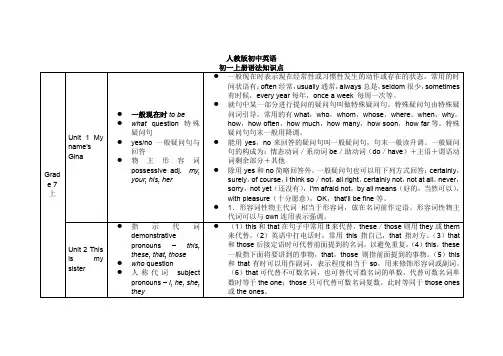
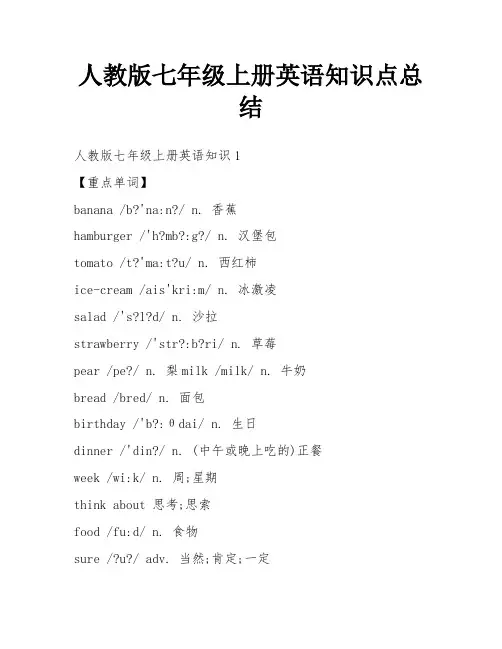
人教版七年级上册英语知识点总结人教版七年级上册英语知识1【重点单词】banana /b?'na:n?/ n. 香蕉hamburger /'h?mb?:g?/ n. 汉堡包tomato /t?'ma:t?u/ n. 西红柿ice-cream /ais'kri:m/ n. 冰激凌salad /'s?l?d/ n. 沙拉strawberry /'str?:b?ri/ n. 草莓pear /pe?/ n. 梨milk /milk/ n. 牛奶bread /bred/ n. 面包birthday /'b?:θdai/ n. 生日dinner /'din?/ n. (中午或晚上吃的)正餐week /wi:k/ n. 周;星期think about 思考;思索food /fu:d/ n. 食物sure /?u?/ adv. 当然;肯定;一定How about...? (提出建议)......怎么样? burger /'b?:g?/ n. (=hamburger)汉堡包vegetable /'ved?t?bl/ n. 蔬菜fruit /fru:t/ n. 水果right /rait/ adj. 正确的;适当的apple /'?pl/ n. 苹果then /?en/ adv. 那么egg /eg/ n. 蛋;鸡蛋carrot /'k?r?t/ n. 胡萝卜rice /rais/ n. 大米;米饭chicken /'t?ikin/ n. 鸡肉so /s?u/ conj. (引出评论或问题)那么breakfast /'brekf?st/ n. 早餐;早饭lunch /l?nt?/ n. 午餐star /sta:/ n. 明星;星星eat /i:t/ v. 吃well /wel/ adv. 好;令人满意地habit /'h?bit/ n. 习惯healthy /'helθi/ adj. 健康的really /'ri:?li/ adv. 真正地question /'kwest??n/ n. 问题want /w?nt/ v. 需要;想要be /bi:/ v. 变成fat /f?t/ adj. 肥的;肥胖的一.短语归纳1.John’s birthdaydinner 约翰的生日晚餐2.next week 下周3.think about 思考、考虑4.how about 怎么样5.some fruit 一些水果6.his birthday 他的生日7.sport star 体育明星 8.eating habits 饮食习惯9.for breakfast 作为早餐 10.for dinner 作为晚餐11.one lastquestion 最后一个问题 12.healthy food 健康的食品二.重点句型:1.have sth 吃……2.—Do you like…? 你喜欢…吗?—Yes, I do / No, I don’t. 是的,我喜欢/不,我不喜欢。
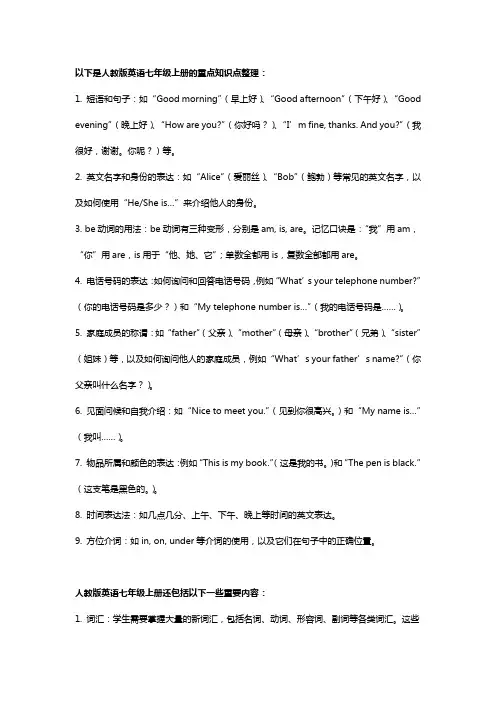
以下是人教版英语七年级上册的重点知识点整理:1. 短语和句子:如“Good morning”(早上好)、“Good afternoon”(下午好)、“Good evening”(晚上好)、“How are you?”(你好吗?)、“I’m fine, thanks. And you?”(我很好,谢谢。
你呢?)等。
2. 英文名字和身份的表达:如“Alice”(爱丽丝)、“Bob”(鲍勃)等常见的英文名字,以及如何使用“He/She is…”来介绍他人的身份。
3. be动词的用法:be动词有三种变形,分别是am, is, are。
记忆口诀是:“我”用am,“你”用are,is用于“他、她、它”;单数全都用is,复数全部都用are。
4. 电话号码的表达:如何询问和回答电话号码,例如“What’s your telephone number?”(你的电话号码是多少?)和“My telephone number is…”(我的电话号码是……)。
5. 家庭成员的称谓:如“father”(父亲)、“mother”(母亲)、“brother”(兄弟)、“sister”(姐妹)等,以及如何询问他人的家庭成员,例如“What’s your father’s name?”(你父亲叫什么名字?)。
6. 见面问候和自我介绍:如“Nice to meet you.”(见到你很高兴。
)和“My name is…”(我叫……)。
7. 物品所属和颜色的表达:例如“This is my book.”(这是我的书。
)和“The pen is black.”(这支笔是黑色的。
)。
8. 时间表达法:如几点几分、上午、下午、晚上等时间的英文表达。
9. 方位介词:如in, on, under等介词的使用,以及它们在句子中的正确位置。
人教版英语七年级上册还包括以下一些重要内容:1. 词汇:学生需要掌握大量的新词汇,包括名词、动词、形容词、副词等各类词汇。
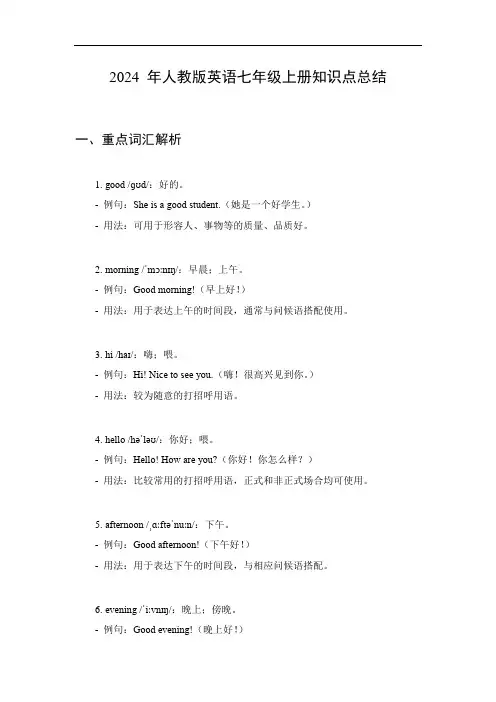
2024 年人教版英语七年级上册知识点总结一、重点词汇解析1.good /ɡʊd/:好的。
-例句:She is a good student.(她是一个好学生。
)-用法:可用于形容人、事物等的质量、品质好。
2.morning /ˈmɔːnɪŋ/:早晨;上午。
-例句:Good morning!(早上好!)-用法:用于表达上午的时间段,通常与问候语搭配使用。
3.hi /haɪ/:嗨;喂。
-例句:Hi! Nice to see you.(嗨!很高兴见到你。
)-用法:较为随意的打招呼用语。
4.hello /həˈləʊ/:你好;喂。
-例句:Hello! How are you?(你好!你怎么样?)-用法:比较常用的打招呼用语,正式和非正式场合均可使用。
5.afternoon /ˌɑːftəˈnuːn/:下午。
-例句:Good afternoon!(下午好!)-用法:用于表达下午的时间段,与相应问候语搭配。
6.evening /ˈiːvnɪŋ/:晚上;傍晚。
-例句:Good evening!(晚上好!)-用法:用于晚上的时间段,作为问候语的一部分。
7.how /haʊ/:怎样;如何。
-例句:How are you?(你怎么样?)-用法:用于询问方式、情况等。
8.are /ɑː(r); ə(r)/:是。
-例句:You are a good boy.(你是一个好男孩。
)-用法:与主语搭配表示“是”的状态。
9.you /juː/:你;你们。
-例句:How are you?(你怎么样?)-用法:第二人称代词,可单指“你”,也可表示“你们”。
10.fine /faɪn/:健康的;美好的。
-例句:I'm fine. Thank you.(我很好。
谢谢你。
)-用法:通常用于回答“How are you?”,表示身体状况良好或情况不错。
二、重点短语1.good morning:早上好。
-例句:Good morning, everyone!(大家早上好!)-用法:早上见面时的问候语。
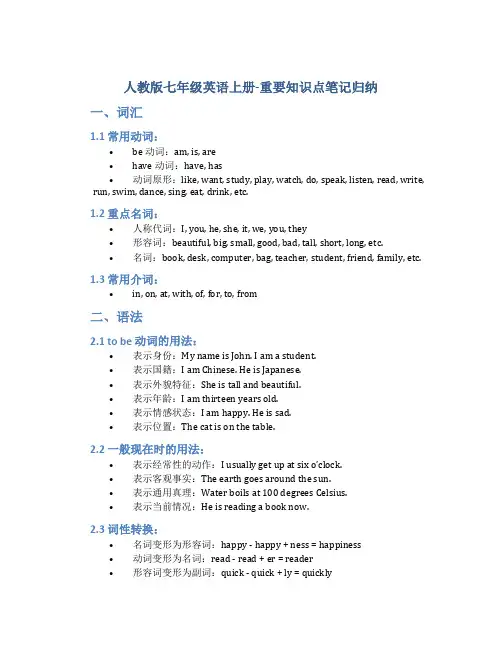
人教版七年级英语上册-重要知识点笔记归纳一、词汇1.1 常用动词:•be 动词:am, is, are•have 动词:have, has•动词原形:like, want, study, play, watch, do, speak, listen, read, write, run, swim, dance, sing, eat, drink, etc.1.2 重点名词:•人称代词:I, you, he, she, it, we, you, they•形容词:beautiful, big, small, good, bad, tall, short, long, etc.•名词:book, desk, computer, bag, teacher, student, friend, family, etc.1.3 常用介词:•in, on, at, with, of, for, to, from二、语法2.1 to be 动词的用法:•表示身份:My name is John. I am a student.•表示国籍:I am Chinese. He is Japanese.•表示外貌特征:She is tall and beautiful.•表示年龄:I am thirteen years old.•表示情感状态:I am happy. He is sad.•表示位置:The cat is on the table.2.2 一般现在时的用法:•表示经常性的动作:I usually get up at six o’clock.•表示客观事实:The earth goes around the sun.•表示通用真理:Water boils at 100 degrees Celsius.•表示当前情况:He is reading a book now.2.3 词性转换:•名词变形为形容词:happy - happy + ness = happiness•动词变形为名词:read - read + er = reader•形容词变形为副词:quick - quick + ly = quickly三、基础句型3.1 be 动词句型:•肯定句:I am a student. / He is my friend.•否定句:I am not a teacher. / She is not tall.•疑问句:Are you Chinese? / Is he a doctor?3.2 一般现在时句型:•肯定句:I usually go to school by bus.•否定句:I don’t like sports.•疑问句:Do you like pizza? / Does she speak English?3.3 祈使句:•意义:表示命令、请求、建议等。
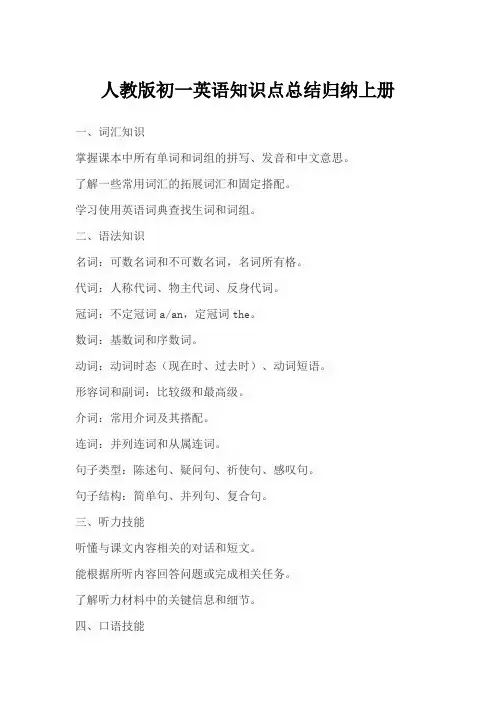
人教版初一英语知识点总结归纳上册一、词汇知识
掌握课本中所有单词和词组的拼写、发音和中文意思。
了解一些常用词汇的拓展词汇和固定搭配。
学习使用英语词典查找生词和词组。
二、语法知识
名词:可数名词和不可数名词,名词所有格。
代词:人称代词、物主代词、反身代词。
冠词:不定冠词a/an,定冠词the。
数词:基数词和序数词。
动词:动词时态(现在时、过去时)、动词短语。
形容词和副词:比较级和最高级。
介词:常用介词及其搭配。
连词:并列连词和从属连词。
句子类型:陈述句、疑问句、祈使句、感叹句。
句子结构:简单句、并列句、复合句。
三、听力技能
听懂与课文内容相关的对话和短文。
能根据所听内容回答问题或完成相关任务。
了解听力材料中的关键信息和细节。
四、口语技能
能模仿课文中的对话进行简单交流。
能用所学词汇和语法知识表达自己的观点和想法。
了解并遵守英语口语交际的基本礼仪。
五、阅读技能
能读懂与课文内容相关的短文和对话。
能根据所读内容回答问题或完成相关任务。
了解阅读材料中的关键信息和细节,提高阅读理解能力。
六、写作技能
能模仿课文中的例句进行简单写作。
能用所学词汇和语法知识写出简单的句子和段落。
了解并遵守英语写作的基本规范,如书写工整、标点符号使用正确等。
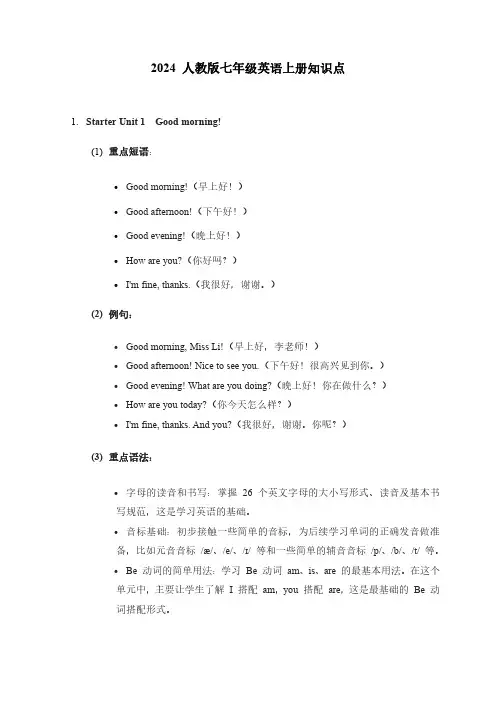
2024人教版七年级英语上册知识点1.Starter Unit1Good morning!(1)重点短语:∙Good morning!(早上好!)∙Good afternoon!(下午好!)∙Good evening!(晚上好!)∙How are you?(你好吗?)∙I'm fine,thanks.(我很好,谢谢。
)(2)例句:∙Good morning,Miss Li!(早上好,李老师!)∙Good afternoon!Nice to see you.(下午好!很高兴见到你。
)∙Good evening!What are you doing?(晚上好!你在做什么?)∙How are you today?(你今天怎么样?)∙I'm fine,thanks.And you?(我很好,谢谢。
你呢?)(3)重点语法:∙字母的读音和书写:掌握26个英文字母的大小写形式、读音及基本书写规范,这是学习英语的基础。
∙音标基础:初步接触一些简单的音标,为后续学习单词的正确发音做准备,比如元音音标/æ/、/e/、/ɪ/等和一些简单的辅音音标/p/、/b/、/t/等。
∙Be动词的简单用法:学习Be动词am、is、are的最基本用法。
在这个单元中,主要让学生了解I搭配am,you搭配are,这是最基础的Be动词搭配形式。
2.Starter Unit2What's this in English?:(1)重点单词:map(地图)cup(杯子)ruler(尺子)pen(钢笔)orange(橙子)jacket(夹克衫)key(钥匙)quilt(被子)what(什么)in(在……里)English(英语;英文)。
(2)重点短语:∙询问物品:What's this in English?(这个用英语怎么说?)、What's that inEnglish?(那个用英语怎么说?)∙回答方式:It's a/an...(它是一个……)。
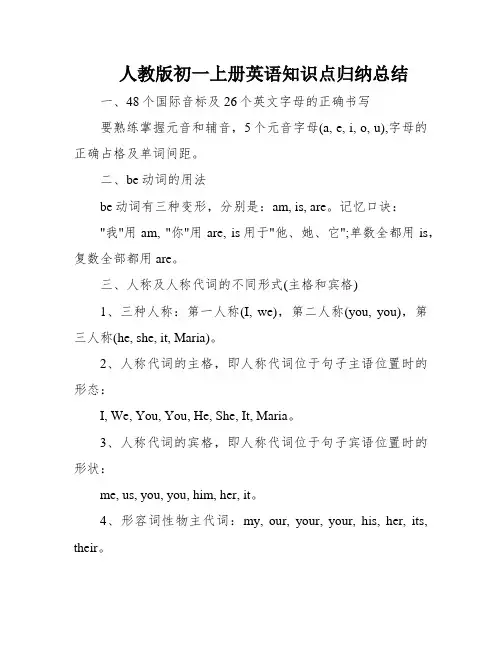
人教版初一上册英语知识点归纳总结一、48个国际音标及26个英文字母的正确书写要熟练掌握元音和辅音,5个元音字母(a, e, i, o, u),字母的正确占格及单词间距。
二、be动词的用法be动词有三种变形,分别是:am, is, are。
记忆口诀:"我"用am, "你"用are, is用于"他、她、它";单数全都用is,复数全部都用are。
三、人称及人称代词的不同形式(主格和宾格)1、三种人称:第一人称(I, we),第二人称(you, you),第三人称(he, she, it, Maria)。
2、人称代词的主格,即人称代词位于句子主语位置时的形态:I, We, You, You, He, She, It, Maria。
3、人称代词的宾格,即人称代词位于句子宾语位置时的形状:me, us, you, you, him, her, it。
4、形容词性物主代词:my, our, your, your, his, her, its, their。
5、名词性物主代词:mine, ours, yours, yours, his, hers, its, theirs。
6、反身代词:myself, ourselves, yourself, yourselves, himself, herself, itself,XXX。
四、基数词(表示数量多少的词,大致相当于代数里的自然数)zero, one, two, three, four, five, six, seven, eight, nine, ten, eleven, XXX,XXX, fourteen, fifteen, XXX, XXX, XXX, XXX, XXX,XXX-one, twenty-two, XXX-three,twenty-four, XXX-five, XXX-six,XXX-seven, XXX-eight, XXX-nine, thirty, forty, fifty, sixty,XXX,eighty, ninety, one hundred,one XXX。
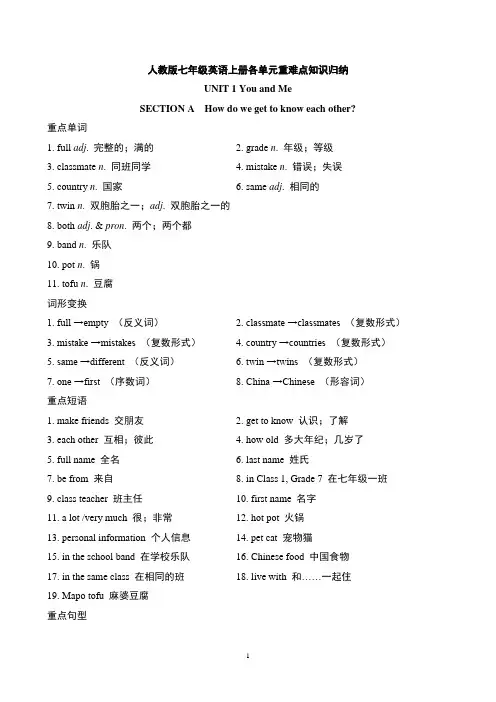
人教版七年级英语上册各单元重难点知识归纳UNIT 1 You and MeSECTION A How do we get to know each other?重点单词1. full adj. 完整的;满的2. grade n. 年级;等级3. classmate n. 同班同学4. mistake n. 错误;失误5. country n. 国家6. same adj. 相同的7. twin n. 双胞胎之一;adj. 双胞胎之一的8. both adj. & pron. 两个;两个都9. band n. 乐队10. pot n. 锅11. tofu n. 豆腐词形变换1. full →empty (反义词)2. classmate →classmates (复数形式)3. mistake →mistakes (复数形式)4. country →countries (复数形式)5. same →different (反义词)6. twin →twins (复数形式)7. one →first (序数词)8. China →Chinese (形容词)重点短语1. make friends 交朋友2. get to know 认识;了解3. each other 互相;彼此4. how old 多大年纪;几岁了5. full name 全名6. last name 姓氏7. be from 来自8. in Class 1, Grade 7 在七年级一班9. class teacher 班主任10. first name 名字11. a lot /very much 很;非常12. hot pot 火锅13. personal information 个人信息14. pet cat 宠物猫15. in the school band 在学校乐队16. Chinese food 中国食物17. in the same class 在相同的班18. live with 和……一起住19. Mapo tofu 麻婆豆腐重点句型1. —How old are you? 你多大了?—I'm 12 years old.我十二岁。
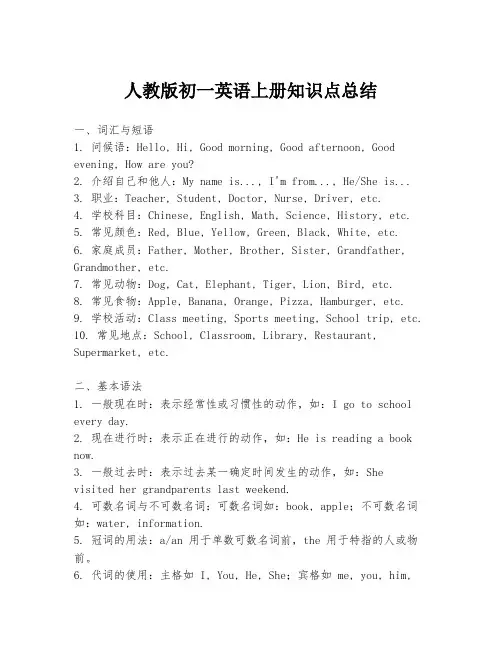
人教版初一英语上册知识点总结一、词汇与短语1. 问候语:Hello, Hi, Good morning, Good afternoon, Good evening, How are you?2. 介绍自己和他人:My name is..., I'm from..., He/She is...3. 职业:Teacher, Student, Doctor, Nurse, Driver, etc.4. 学校科目:Chinese, English, Math, Science, History, etc.5. 常见颜色:Red, Blue, Yellow, Green, Black, White, etc.6. 家庭成员:Father, Mother, Brother, Sister, Grandfather, Grandmother, etc.7. 常见动物:Dog, Cat, Elephant, Tiger, Lion, Bird, etc.8. 常见食物:Apple, Banana, Orange, Pizza, Hamburger, etc.9. 学校活动:Class meeting, Sports meeting, School trip, etc.10. 常见地点:School, Classroom, Library, Restaurant, Supermarket, etc.二、基本语法1. 一般现在时:表示经常性或习惯性的动作,如:I go to school every day.2. 现在进行时:表示正在进行的动作,如:He is reading a book now.3. 一般过去时:表示过去某一确定时间发生的动作,如:Shevisited her grandparents last weekend.4. 可数名词与不可数名词:可数名词如:book, apple;不可数名词如:water, information.5. 冠词的用法:a/an 用于单数可数名词前,the 用于特指的人或物前。
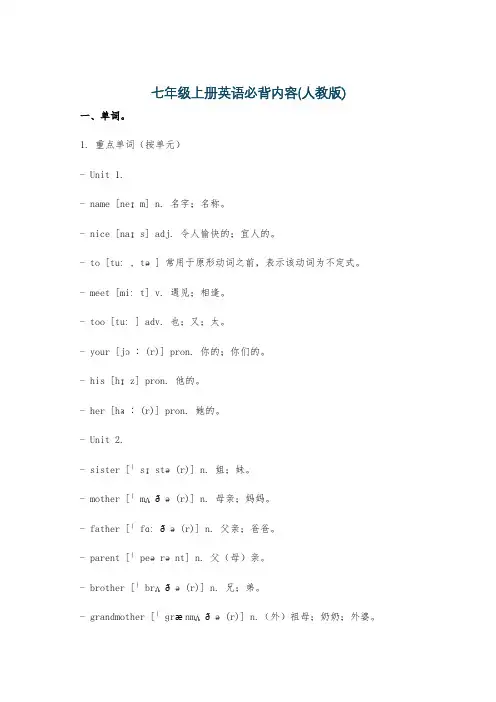
七年级上册英语必背内容(人教版)一、单词。
1. 重点单词(按单元)- Unit 1.- name [neɪm] n. 名字;名称。
- nice [naɪs] adj. 令人愉快的;宜人的。
- to [tuː, tə] 常用于原形动词之前,表示该动词为不定式。
- meet [miːt] v. 遇见;相逢。
- too [tuː] adv. 也;又;太。
- your [jɔː(r)] pron. 你的;你们的。
- his [hɪz] pron. 他的。
- her [hɜː(r)] pron. 她的。
- Unit 2.- sister [ˈsɪstə(r)] n. 姐;妹。
- mother [ˈmʌðə(r)] n. 母亲;妈妈。
- father [ˈfɑːðə(r)] n. 父亲;爸爸。
- parent [ˈpeərənt] n. 父(母)亲。
- brother [ˈbrʌðə(r)] n. 兄;弟。
- grandmother [ˈɡrænmʌðə(r)] n.(外)祖母;奶奶;外婆。
- grandfather [ˈɡrænfɑːðə(r)] n.(外)祖父;爷爷;外公。
- grandparent [ˈɡrænpeərənt] n. 祖父(母);外祖父(母)- family [ˈfæməli] n. 家;家庭。
- Unit 3.- pencil [ˈpensl] n. 铅笔。
- book [bʊk] n. 书。
- eraser [ɪˈreɪzə(r)] n. 橡皮。
- box [bɒks] n. 箱;盒。
- schoolbag [ˈskuːlbæɡ] n. 书包。
- dictionary [ˈdɪkʃənri] n. 词典;字典。
- his [hɪz] pron. 他的。
- mine [maɪn] pron. 我的。
Starter Unit1Good Morning! Units1—3【重点单词】good/gud/adj.好的morning/'mɔ:niŋ/n.早晨;上午Good morning!早上好!hi/hai/interj.(用于打招呼)嗨;喂hello/hə'ləu/interj.你好;喂afternoon/,a:ftə'nu:n/n.下午Good afternoon!下午好!evening/'i:vniŋ/n.晚上;傍晚Good evening!晚上好!how/hau/adv.怎样;如何are/a:/v.是you/ju:/pron.你;你们How are you?你好吗?I/ai/pron.我am/æm/v.是fine/fain/adj.健康的;美好的thanks/θæŋks/interj.&n.感谢;谢谢OK/əu'kei/interj.&adv.好;可以what/wɔt/pron.&adj.什么is/iz/v.是this/ðis/pron.这;这个in/in/prep.(表示使用语言、材料等)用;以English/'iŋgliʃ/n.英语adj.英格兰的;英语的in English用英语map/mæp/n.地图cup/kʌp/n.杯子ruler/'ru:lə/n.尺;直尺pen/pen/n.笔;钢笔orange/'ɔrindʒ/n.橙子jacket/'dʒækit/n.夹克衫;短上衣key/ki:/n.钥匙quilt/kwilt/n.被子;床罩it/it/pron.它a/ə/art.(用于单数可数名词前)一(人、事、物) that/ðæt/pron.那;那个spell/spel/v.用字母拼;拼写please/pli:z/interj.(用于客气地请求或吩咐)请color/'kʌlə/n.(=colour)颜色red/red/adj.&n.红色(的)yellow/'jeləu/adj.&n.黄色(的)green/gri:n/adj.&n.绿色(的)blue/blu:/adj.&n.蓝色(的)black/blæk/adj.&n.黑色(的)white/wait/adj.&n.白色(的)purple/'pə:pl/adj.&n.紫色(的)brown/braun/adj.&n.棕色(的);褐色(的)the/ði;ðə/art.指已提到或易领会到的人或事now/nau/adv.现在;目前see/si:/v.理解;明白can/kæn/modal v.能;会say/sei/v.说;讲my/mai/pron.我的知识点:1.短语归纳:good morning早上好good afternoon下午好good evening晚上好name list名单an English name英文名字2.必背典句:(1)Good morning,Alice!早上好,艾丽斯!(2)Good afternoon!下午好!(3)Hi,Bob!你好,鲍勃!(4)Hello,Frank!你好,弗兰克!(5)Good evening晚上好!(6)—How are you?你好吗?—I’m fine,thanks.How are you?我很好,谢谢。
人教版七年级英语上册知识点总结归纳整理人教版七年级英语上册知识点总结归纳整理:一、基础语法知识点:1. 人称代词:主格代词、宾格代词、物主代词、反身代词等;2. 一般现在时:主谓一致、第三人称单数的变化规则、用法(谈论客观现象、习惯性动作、主语是第一人称单数时引导的问句等);3. 形容词的比较级和最高级:形容词比较级的用法、规则、形容词最高级的用法、规则;4. 简单现在进行时:用法、构成规则、特殊短语的运用;5. 一般过去时:规则动词和不规则动词的过去式变化形式、肯定、否定、一般疑问句的构成;6. 句型转换:肯定句、否定句、一般疑问句的转换等;7. 句子的基本成分:主语、谓语、宾语、表语等;8. 数词:基数词、序数词的用法;9. 形容词的位置:修饰名词的位置;10. 反意疑问句:询问对方是否同意或否定自己的说法;11. 祈使句:表示命令、请求、建议等;12. there be句型:表示某地有某物或某人;13. 介词:in、on、at的用法;14. 情态动词:can、could、may、might的用法;15. 祈使句;16. 情态动词:can、could、may、might的用法。
二、常见词组和句型:1. Greetings and Introductions问候和自我介绍(1) Hello! Hi! 你好!(2) What's your name? 你叫什么名字?(3) My name is…我叫…(4) Nice to meet you! 很高兴认识你!2. Numbers and Dates数字和日期(1) What's your telephone number? 你的电话号码是多少?(2) My telephone number is…我的电话号码是…(3) When is your birthday? 你的生日是什么时候?(4) My birthday is on…我的生日是在…3. Time时间(1) What time is it? 现在几点钟?(2) It's… o'clock. 具体时间(3) What time do you…? 你什么时候…(4) I… at…我在什么时间做…4. Class Schedule课程表(1) What's your favorite subject? 你最喜欢的科目是什么?(2) My favorite subject is…我最喜欢的科目是…(3) What time is your… class? 你…科在什么时间?(4) My… class is at…我…科在什么时间。
新人教版七年级英语上册知识点总结一、Starter Units 1 - 3知识点。
1. 字母。
- 26个英文字母的大小写书写形式、占格及读音。
大写字母一般占上两格,如A、B等;小写字母占格情况不同,如a、c占中间一格,b、d占上两格,g、p、q占下两格等。
- 字母的分类:元音字母(a, e, i, o, u)和辅音字母(除元音字母外的其他字母)。
2. 单词。
- 常见的问候语单词:hello(你好),hi(嗨),good(好的),morning(早晨),afternoon(下午),evening(晚上)。
- 颜色类单词:red(红色),blue(蓝色),green(绿色),black(黑色),white(白色),yellow(黄色)等。
- 文具类单词:pen(钢笔),pencil(铅笔),ruler(尺子),eraser(橡皮),crayon(蜡笔)等。
3. 句型。
- 问候语:- - Hello, Frank! - Hello, Eric!- - Good morning! - Good morning!- - How are you? - I'm fine, thank you. And you? - I'm OK.- 介绍颜色:- - What color is it? - It's red.- 询问物品:- - What's this in English? - It's a pen.二、Unit 1 My name's Gina.知识点。
1. 单词。
- name(名字),nice(美好的),to(不定式符号,无实义),meet(遇见),too(也),your(你的;你们的),his(他的),her(她的)。
- 名字相关:first name(名),last name(姓),例如:Gina Green中,Gina是first name,Green是last name。
人教版七年级上册英语知识点系统归纳一、单词和短语1. 人称代词- 主格:I, you, he, she, it, we, they- 宾格:me, you, him, her, it, us, them2. 动词- be动词:am, is, are3. 数词- 基数词:one, two, three, four, five, six, seven, eight, nine, ten - 序数词:first, second, third, fourth, fifth, sixth, seventh, eighth, ninth, tenth4. 询问方式和回答- 询问姓名:What's your name? My name is...- 询问年龄:How old are you? I'm ... years old.- 询问国籍:Where are you from? I'm from...- 询问职业:What's your job? I'm a...- 询问日常活动:What do you do on weekends? I usually...5. 学科和科目- 数学:mathematics, math- 英语:English- 物理:physics- 化学:chemistry- 历史:history- 地理:geography- 生物:biology- 音乐:music- 美术:art- 体育:physical education, PE6. 学校设施和地点- 教室:classroom- 图书馆:library- 实验室:laboratory- 操场:playground- 餐厅:canteen- 办公室:office- 停车场:parking lot- 校门:school gate二、语法知识1. 句子结构- 主语 + 谓语:I study English.- 主语 + 谓语 + 宾语:She likes apples.- 主语 + 谓语 + 宾语 + 地点:They play basketball at the playground.- 主语 + 谓语 + 宾语 + 时间:We watch TV on weekends.- 主语 + be动词 + 表语:He is a student.2. 一般疑问句- be动词:Is she a teacher? Yes, she is. / No, she isn't.- 一般动词:Do you like sports? Yes, I do. / No, I don't.3. 物主代词- 形容词性物主代词:my, your, his, her, its, our, their- 名词性物主代词:mine, yours, his, hers, its, ours, theirs4. 形容词和副词- 形容词:big, small, tall, short, old, young, happy, sad, interesting, boring- 副词:well, badly, fast, slowly, often, sometimes, always, never5. 介词- in, on, at, under, over, beside, in front of, behind, between6. 时态- 现在时:I study English. / He likes sports.- 过去时:I studied English. / He liked sports.- 将来时:I will study English. / He will like sports.三、日常用语1. 问候语- 早上好:Good morning!- 下午好:Good afternoon!- 晚上好:Good evening!- 晚安:Good night!2. 表达喜欢和不喜欢- 喜欢:I like swimming.- 不喜欢:I don't like playing basketball.3. 请求和允许- 请求:Can I go to the restroom?- 允许:Yes, you can. / No, you can't.4. 表达时间和日期- 现在时间:It's 8 o'clock.- 日期:Today is Monday, June 1st.5. 表达感觉和状态- 感觉:I'm happy. / She is sad.- 状态:I'm hungry. / He is tired.以上是人教版七年级上册英语知识点的系统归纳,包括单词和短语、语法知识和日常用语等内容。
人教版七年级英语上册知识点汇总大全【最新整理】Starter Unit 1: Good Morning!In this unit。
we will learn some essential phrases and sentences that we use to greet people in English.1.Phrases to Know:Good morning: used to greet someone in the morningGood afternoon: used to greet someone in the afternoonGood evening: used to greet someone in the eveningName list: a list of namesAn English name: a name in English2.Sentences to Remember:Good morning。
Alice!: a greeting used in the morningGood afternoon!: a greeting used in the afternoonHi。
Bob!: a casual greetingHello。
Frank!: a formal greetingGood evening!: a greeting used in the eveningHow are you?: a common greeting used to ask someone how they are feelingI'm fine。
thanks。
How are you?: a response to the n "How are you?"I'm OK: a response to the n "How are you?"mon Greetings in English:Hello!: a casual greeting used to say "hi" or get someone's n Hi!: a more informal way to say "hello"Nice to meet you!: a polite way to greet someone when you meet them for the first timeHow do you do?: a formal greeting used when meeting someone for the first timeing Capital Letters:The first letter of the first word in a sentence should be capitalized。
Unit1You and Me(知识讲解)-I'm in Class1,Grade7.我在七年级一班。
5.询问某人的身份:-Who's your class teacher?你的班主任是谁?-It's Ms Gao.是高老师。
6.询问喜好:-What is your favourite sport/food/...?你最喜欢的运动/食物/······是什么?-My favourite sport/food/...is...我最喜欢的运动/食物/······是······7.询问爱好:What are your hobbies?你的爱好是什么?语音1.单元音:/i:/,/I/;/e/,/æ/知识2.缩写重点1.一般现在时中be动词的用法语法2.人称代词和形容词性物主代词How do we make new friends?我们如何交新朋友?(教材第19页)make friends交朋友此短语中的friend要用复数形式。
make friends with...与······交朋友I like making friends.我喜欢交朋友。
I want to make friends with you.我想和你交朋友Section A How do we get to know each other?1.①Peter's full name is Peter Brown.彼得的全名是彼得·布朗。
(教材第20页1c)②Ella's last name is Miller.埃拉的姓是米勒。
(教材第20页1c)③Huìis her first name.慧是她的名字。
人教版初一上册英语知识点归纳总结一、48个国际音标及26个英文字母的正确书写要熟练掌握元音和辅音,5个元音字母(a, e, i, o, u),字母的正确占格及单词间距。
二、be动词的用法be动词有三种变形,分别是:am, is, are。
记忆口诀:"我"用am, "你"用are, is用于"他、她、它";单数全都用is,复数全部都用are。
三、人称及人称代词的不同形式(主格和宾格)1、三种人称:第一人称(I, we),第二人称(you, you),第三人称(he, she, it, Maria)。
2、人称代词的主格,即人称代词位于句子主语位置时的形态:I, We, You, You, He, She, It, Maria。
3、人称代词的宾格,即人称代词位于句子宾语位置时的形态:me, us, you, you, him, her, it。
4、形容词性物主代词:my, our, your, your, his, her, its, their。
5、名词性物主代词:mine, ours, yours, yours, his, hers, its, theirs。
6、反身代词:myself, ourselves, yourself, yourselves, himself, herself, itself, themselves。
四、基数词(表示数量多少的词,大致相当于代数里的自然数)zero, one, two, three, four, five, six, seven, eight, nine, ten, eleven, twelve, thirteen, fourteen, fifteen, sixteen, seventeen, eighteen, nineteen, twenty, twenty-one, twent y-two, twenty-three,twenty-four, twenty-five, twenty-six, twenty-seven, twenty-eig ht, twenty-nine, thirty, forty, fifty, sixty,seventy, eighty, ninety, one hundred,one hu ndred and one。
五、一般疑问句及特殊疑问句1、一般疑问句:能用Yes或No来回答的问句。
一般疑问句句尾读升调。
2、特殊疑问句:不能用Yes或No来回答的问句。
特殊疑问句句尾读降调。
六、可数名词变复数可数名词变复数时,有规则变化和不规则变化两种。
1、规则变化:(1)一般情况直接在词尾加"-s ",如:cake-cakes, bag-bags, day-days, face-faces, orange-oranges等;(2)以s, x, sh, ch结尾的词,要在词尾加"-es ",如:bus-buses, watch-watches, box-boxes 等;(3)以辅音字母加y结尾的词,变y为i再加"-es ",如:baby-babies, country-countries, family-families等;(4)部分以f (e)结尾的词,变f (e)为"ves ",如:knife-knives, half-halves等;(5)以o结尾的词,加"-s "或"-es ",如:zoo-zoos, photo-photos,tomato-tomatoes, potato-potatoes等。
记忆口诀:除了"英雄"hero外,凡是能吃的,加"-es ",不能吃的加"-s "。
2、不规则变化:(1)改变单数名词中的元音字母:man-men, woman-women, foot-feet, tooth-teeth等;(2)单、复同形:sheep-sheep, Chinese-Chinese, Japanese-Japanese等;(3)其他形式:mouse-mice, child-children等。
七、简单句的成分及主谓一致原则最基本构成:主语+谓语+宾语,其中谓语由动词来充当。
主谓一致原则,就是句子的谓语要始终与主语保持数量上的一致性。
当主语是第三人称单数(简称"三单")时,谓语动词也要相应变成单数形式;当主语非"三单"时,谓语动词就用原形。
实意动词变"三单"的规则如下:(1)一般动词在词尾加"-s ",如:like-likes, tell-tells, play-plays等;(2)以字母s, x,ch, sh结尾的动词加"-es ",如:guess-guesses, teach-teaches, watch-watches等;(3)以o结尾的动词一般加"-es ",如:do-does, go-goes等;(4)以辅音字母加y结尾的动词,先变y为i,再加"-而是",如:fly-flies, carry-carries等;(5)have的三单形式是has。
八、冠词的用法(名词前面必须要有冠词) 冠词分为定冠词(the)和不定冠词(a, an)两种。
1、定冠词the表示"特指",可译为"这个"、"那个"、"这些"、"那些"。
2、不定冠词a, an用来表明(可数)名词的数量是"一个"。
an用于以元音开头(注意不是以元音字母开头)的单词前,a则英语非元音开头的单词前。
3、不定冠词a, an与基数词one的区别是:不定冠词不是刻意强调"数量",而基数词则强调"数量"。
九、助动词(do, does )的用法只有实意动词作谓语时才涉及使用助动词。
以like为例:(1)当句子为肯定句时不涉及使用助动词,只涉及"主谓一致"原则。
eg : I like English a lot.Michael likes Chinese food very much.(2)当句子为否定句时,要根据主语的人称来决定使用相应的助动词:当主语为"三单"时,要使用does;当主语为"非三单"时,用助动词原形do。
例如把下列句子变否定句:Kangkang likes math.----Kangkang doesn't like math. They like sports.------They don't like sports.(3)当句子变疑问句时,同样要根据句子的主语来决定在句首使用Do或Does.例如下列句子变问句:Michael likes Chinese Food.----Does Michael like Chinese food? Yes, he does./ No, he doesn't.Jane and Helen like music.----Do Jand and Helen like music? Yes, they do./ No, the y don't.十、名词所有格1、Kangkang's books;T om and Helen's desk; Ann's and Maria's bikes;2、用of表示"......的",但要从of后往of前翻译:a book of mine(我的一本书)3、have与of的区别:have一般表示"主动拥有",往往用于有生命的人或动物;无生命的物体一般不能"主动拥有",表示所属关系时要用of。
例如:I have a new bike. She has two big eyes. a door of the house十一、初一英语上册知识点之课本中的知识点1、Unit 1 --Unit 2(1)问候语:Good morning/ afternoon/ evening.How are you?---Just OK, thank you.How are you?---Not bad, thanks.Hi! Hello! How do you do?(2)道别用语:Nice/ Glad to meet/ see you.(meet用于初次见面,see用于熟人间)Nice to meet/ see you, too.Goodbye. Byebye. Bye. See you (later/ tomorrow/ next time)! So long! Good night!(3)介绍人或者物的句型:This is...(4)Excuse me.与I'm sorry.的区别:Excuse me.是要引起对方的注意,而I'm sorry.则是向对方道歉。
(5)词组be from = come from(6)当问句中问到this/ that时,回答要用it;问到these/ those时,要用they来回答。
例如: What's this in English?----It's an eraser.What are those?----They are books.(7)对Thanks.的回答:That's OK./ You're welcome./ My pleasure.(8)look the same = have the samelooks give sth. to sb. = give sb. sth.be like = look like(9)both与all的区别: both表示"两者都......";all表示"三者及以上都......"。
2、Unit 3--Unit 4(1)speak的用法speak与say不同:speak表示"说"的动作,不表示"说"的内容;say则表示"说"的内容。
speak后面除了能接"语言"外,不能直接接东西,后面加了to则表示"对......说"。